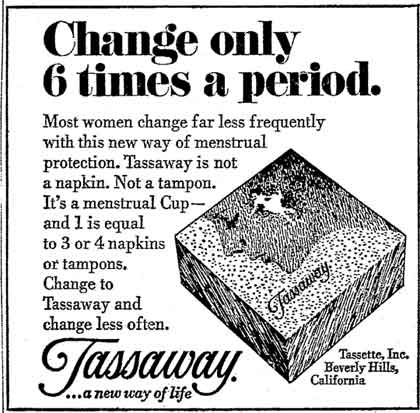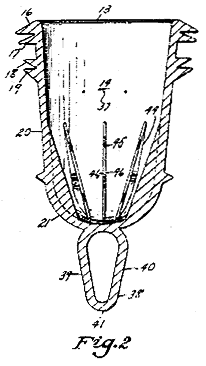Leona
Chalmer's 1937
book with a
drawing of a cup.
And
read comments from people who have
used a cup.
Do cups
cause endometriosis? Not enough evidence,
says the FDA.


|

A History of the
Menstrual Cup (continued)
Women Tossed Away
the Tassaway
Below: a newspaper Tassaway ad
from its first year, in the Reno
[Nevada] Evening Gazette, November
4, 1970. More ads: 1971 and 1972, 1972
& 1973
Dutch ads, and instructions
for
use of the cup.
|
 |
Below:
The Tassaway mark in the U.S.
Patent and Trademark Office, filed
Aug. 9. 1966 but described as
having been in use since 1963.
|
 |
 It's a short story. It's a short story.
In 1970, Tassette, Inc., the
maker of the now-defunct Tassette
menstrual cup, launched its first
promotion since the early 1960s,
this time for its new disposable
cup, Tassaway
(bottom of page), which was
made of a non-absorbent
elastomeric polymer (patent
drawing at left). Robert Oreck,
the president of the company,
hoped the new cup would generate
more money than the old one by
solving the two problems Oreck
thought were at the heart of the
failure of Tassette: women did not
want to wash and re-use the cup,
and satisfied customers would
not quickly buy another one
because they could use them for
several years.
Eduardo F. Peña, M.D.,
Fellow of the American College of
Obstetricians and Gynecologists,
tested the Tassette at the
company's request in 1961 (the
journal Obstetrics and Gynecology
published his report "Advantages
of the Menstrual Cup" - Tassette,
Inc. funded the study - in the May
1962 issue), and talked with a
Barron's reporter in 1970 before a
talk he gave about Tassette (not
the new Tassaway) at the Sixth
World Congress of Obstetrics and
Gynecology.
Peña's judgment was
positive, including "[u]se of the
cup is hygienic in that it avoids
the infections commonly associated
with sanitary napkins and
tampons." What he meant were
mostly infections caused by the
Trichomonas vaginalis protozoan
(he said that Trichomonas caused
80% of vaginal infections he saw
in his practice in Miami) and the
Candida albicans fungus, which
causes moniliasis, which thrives
in Florida's subtropical climate.
Cystitis is also a problem with
women using pads, because feces on
the napkin can bring Esherichia
coli bacteria to the urethra.
(Read the Dickinson
Report from 1945 about these
very problems.) The doctor
recommended that users dip the cup
into a weak solution of chlorine
bleach after the period to kill
any adhering bacteria.
(In an article from the "toxic
shock era," which started with
menstrual products in the late
1970s, in Infectious Diseases in
Obstetrics and Gynecology
(2:140-145, 1994), Philip M.
Tierno, Jr., and Bruce A. Hanna of
the Departments of Microbiology
and Pathology of the New York
University School of Medicine,
wrote that "S[taphylococcus]
aureus MN8 produced no TSST-1 when
grown in the presence of
Tassaway," thus absolving Tassaway
of any charge of promoting toxic
shock.)
Barron's reporter Alan Abelson,
who wrote the column "Up and Down
Wall Street," criticized the
doctor's statement that the cup
was "an economically viable
product." He said it was a
judgment for the consumer to make.
He was only partly right. Suspicions of
fraud involving shares in the
company surfaced. (See a
share
from 1971.) Tassette, Inc.,
reported selling thousands of
Tassaways, but not nearly enough
to justify the high value of each
share.
On July 17, 1972, a federal
judge in Los Angeles issued an
order permanently enjoining Robert
Oreck and Tassette, Inc., from
violating the registration
provisions of the Securities Act
of 1933 and the anti-fraud
provisions of the Securities Act
of 1933 and the Securities
Exchange Act of 1934.
Interestingly enough, apparently
women could still buy the cup in
The Netherlands in 1972 and 1973,
as these ads here and
here
show. (More ads: 1971 and 1972,
and instructions
for
use of the cup.)
Tassette, Inc., was essentially
dead, but it had hardly lived.
Just as with Tassette, the company
never made a profit. The company
owed J. Walter Thompson, the
advertising agency, a little over
$1 million, while having assets of
only $228,829; a Tassette lawyer
lowered that value to $30,000,
partly because the unusual nature
of the equipment reduced its
attractiveness.
Not until the late 1980s did The
Cup reappear. This time it has
succeeded modestly. I'm talking
about The Keeper (Part 4).
(Most of
the information above about
Tassette, Tassaway and Chalmer's
patent came from Advertising
Age, Barron's, Drug Trade News,
Editor and Publisher, Investment
Dealer's Digest from the 1960s
and 1970s; and from a Stock
Prospectus dated 28 August 1961.
Mr. Oreck refused my request for
an interview, referring me to
another company official; I
could not find her.)
© 1997-2006 Harry Finley.
It is illegal to reproduce or
distribute any of the work on this
Web site in any manner or medium
without written permission of the
author. Please report suspected
violations to hfinley@mum.org
|
|